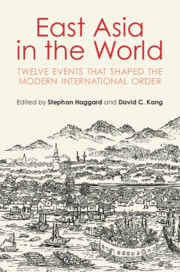Book contents
- East Asia in the World
- East Asia in the World
- Copyright page
- Contents
- Figures and Tables
- Contributors
- Acknowledgments
- Part I Historicizing East Asian International Relations
- Part II The East Asian System over Time
- 4 East Asia’s First World War, 643–668
- 5 The Founding of the Korean Chosŏn Dynasty, 1392
- 6 The Ming Invasion of Vietnam, 1407–1427
- 7 Ming Grand Strategy during the Great East Asian War, 1592–1598
- 8 The Qing Unification, 1618–1683
- Part III Contact: East and West
- Conclusion
- Bibliography
- Index
4 - East Asia’s First World War, 643–668
from Part II - The East Asian System over Time
Published online by Cambridge University Press: 08 October 2020
- East Asia in the World
- East Asia in the World
- Copyright page
- Contents
- Figures and Tables
- Contributors
- Acknowledgments
- Part I Historicizing East Asian International Relations
- Part II The East Asian System over Time
- 4 East Asia’s First World War, 643–668
- 5 The Founding of the Korean Chosŏn Dynasty, 1392
- 6 The Ming Invasion of Vietnam, 1407–1427
- 7 Ming Grand Strategy during the Great East Asian War, 1592–1598
- 8 The Qing Unification, 1618–1683
- Part III Contact: East and West
- Conclusion
- Bibliography
- Index
Summary
Between 643 and 668 CE, East Asia was engulfed by a war that drew in nearly every state in the region. During the preceding centuries, peripheral states used tribute and investiture relations to balance competing Chinese empires against each other, but the unification of China under the Sui disrupted this strategy. As tension emerged between Koguryŏ and the Chinese empires, Silla and Paekche repeatedly sought to advance their interests by drawing the Sui and Tang into conflicts on the Korean peninsula. The result was a massive reconfiguration of the region: Paekche and Koguryŏ were destroyed, Silla consolidated control of the Korean peninsula, and Yamato entered a period of rapid centralization, while the Tang retreated. These events demand our attention because they offer insight into the flexibility of East Asian tribute and investiture relations, which shifted but endured throughout this period of extreme volatility.
- Type
- Chapter
- Information
- East Asia in the WorldTwelve Events That Shaped the Modern International Order, pp. 67 - 80Publisher: Cambridge University PressPrint publication year: 2020
- 1
- Cited by

